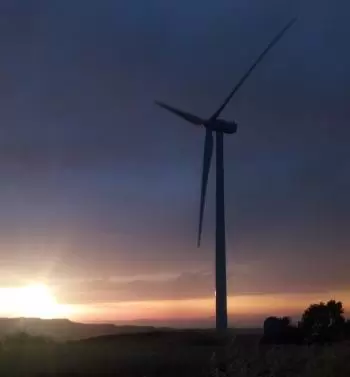
A wind turbine is a machine that transforms wind energy into electrical energy. Windmills are usually part of wind farms and provide electricity to the grid.
Wind turbines are the essential element of wind power and constitute a clean and renewable energy source.
The nacelle is the large housing at the top of the wind turbine that contains all the essential components, including the gearbox, generator, and yaw system. The blades are attached to the rotor, which is connected to the nacelle through the main shaft. The tower supports the nacelle and blades and can be made from steel, concrete, or tubular sections. The foundation anchors the tower to the ground.
The essential windmill parts are the following:
Wind turbine foundation
A wind turbine must be well anchored to the ground on which it is located. Sometimes a shallow foundation is used for cost reasons. The base is made of concrete and is equipped with penetrations through which electrical wiring can pass.
In offshore wind farms, there are three common types of foundations:
-
Three-legged foot
-
Scoop base
-
Straight mast.
However, the possibility of making floating windmills without direct anchoring to the seabed is being investigated.
Wind tower mast
The mast of a windmill must be able to withstand many loads. So, in addition to supporting the weight of the gondola and the electric generator, it has to be resistant to the wind load. Inside the mast is a ladder, possibly an elevator, and power cables. The most modern designs are made of tubular steel tubes.
The wind turbines currently installed are an average of 100 meters high. However, wind turbines with higher heights have already been built. Wind speed increases with size, so you perform better at higher altitudes.
Nacelle and electric generator
The nacelle is the cabin on top of a wind turbine which contains essential elements like the shafts, the gearbox, and the electrical generator.
They have a yaw system incorporated to ensure that it is constantly faced with the wind.
The electric generator converts the mechanical energy of the shaft into electricity.
The gearbox increases the shaft's rotation speed at the input of the generator.
Wind turbines are equipped with an aerodynamic braking system to stop them during emergency or maintenance situations.
In the nacelles, a wind meter is installed to activate or deactivate the rotation of the blades depending on the wind speed.
Wind turbines also have an orientation system to face the blades in the direction of the wind.
The generator
A generator is another crucial component of a wind turbine. Its function is to convert mechanical energy to electricity according to the principle of Faraday's law.
The generator consists basically of an electric coil (usually made of copper) stationed within a magnetic field, such that it is under the influence of magnetism. By rotating this coil at high speed from the high-speed shaft within the magnetic field, electricity is produced through electromagnetic induction.
The wind vane
A wind vane is a device that collects and gives information about the wind’s direction. It is usually mounted on top of the wind turbine tower.
Wind vans are usually made of metal or wood and have a tail that points into the wind. The tail is attached to a pivot so that it can turn freely. This part of the turbine gives essential information to the control system in order to orient the turbine rotor and the blades toward the most efficient position.
Blades of a wind turbine
The blades are essential for wind turbine components because they interact directly with the wind. They are aerodynamically designed to convert the wind's kinetic energy into mechanical energy transmitted to the rotor shaft.
Modern rotor blades are made of fiberglass or carbon fiber-reinforced plastic. The maximum length of modern wind turbine blades is about 65 meters for onshore turbines and about 85 meters for offshore turbines. The longer the blade, the higher the speed at the end of the blade.
They are attached to the low-speed shaft, which transmits the mechanical energy to the high-speed shaft using a gearbox.
The blades rotate at a constant speed of between 15 and 40 revolutions per minute. However, some wind turbines operate at a variable rate. This is because the revolutions of rotation depend on a physical limit, the maximum speed of the tip of the blades.
Depending on the design, the number of blades can vary. Nevertheless, the vast majority have three blades in the rotor.
The pitch control
The pitch control is the system that changes the angular orientation of the blades. Its function is to optimize the aerodynamics of the blade according to the relative wind speed.